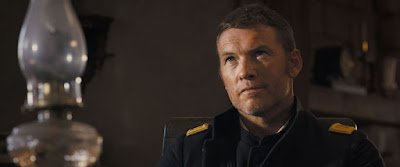 |
| Image courtesy of New Line Cinema. |
Kevin Costner's costly, multi-film project kicks off with somewhat mixed success in "Horizon: An American Saga Part I." It's clear that Costner, who has previously directed such westerns as the Oscar winning "Dances with Wolves" and "Open Range," is aiming for a saga on the level of "How the West Was Won," a film made by several famous filmmakers - including John Ford - that was set against the backdrop of the post-Civil War years.
The film's first hour is a bit of a slog, despite the fact that there's a lot going on. A settlement in the San Pedro Valley known as Horizon, circa 1859, is attacked early on by Apaches in a scene that feels somewhat regressive following last year's "Killers of the Flower Moon." Regardless, there's a taut sequence in which a family and some friends are holed up in a house as the attack progresses outside.
Meanwhile, a woman (Jena Malone) shoots a man prior to this scene, takes a child, and flees, arriving at the Horizon settlement. Not far behind are a group of ruthless men tracking down the woman involved in the shooting. Elsewhere, a posse forms to seek out the Apaches who carried out the attack - or, honestly, any Native American will seemingly do for this bunch - and carry out retribution. Meanwhile, a tribal elder criticizes the Apache warrior who led the attack, arguing that this act will bring bloodshed on their people. There's also a wagon train being led by Luke Wilson.
"Horizon," as you can see, is a film full of meanwhiles. There's a lot going on - too much, in fact, that when we finally get to a point late in the film when a woman (Sienna Miller) who escaped the initial attack finds a bit of romance with an army lieutenant (Sam Worthington), it comes as a surprise. We never saw this coming because there are so many characters stretched thin here that they are given little time to be developed.
This is a three-hour movie, but it's not until about the first hour to 90 minutes when things pick up. Costner the director saved the best parts for Costner the actor, whose arrival about an hour-plus into the picture is welcome. He plays Hayes, a somewhat mysterious man who shows up at another settlement where Malone's character is hiding out and befriends a young sex worker (Abbey Lee). Their friendship livens up the picture, but also leads to some tension when Hayes runs afoul of one of the bounty hunters, who makes the mistake of drawing on Hayes.
From then on, "Horizon" picks up considerably, although I wasn't sure what to make of the last three or four minutes of the film, which seemed to act as a scored teaser for "Part II." This is a film that takes its time getting where it's going and some viewers might lose patience during the first 75 minutes. Once Costner appears onscreen, it picks up steam and, on the whole, ends up being fairly decent.
Whether the second part ends up bringing all of these characters together in a satisfactory manner remains to be seen. The first part of the saga isn't half bad. It could have used some trimming and, perhaps, a few less characters. It doesn't represent Costner's best work behind the camera (that would be "Dances with Wolves"), but it's a patient, old fashioned western saga that has some gorgeous vistas, solid performances, and just enough interest to make me want to see what happens in the second installment, coming in August.





